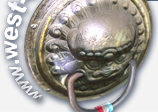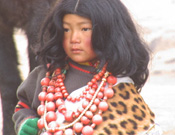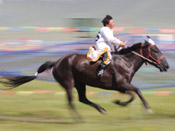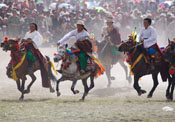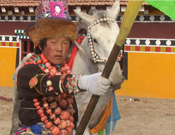| 23Days Amnye Machen Trekking &
Shaman Festival Tour
Day1 --Beijing
Arrive in Beijing and check into hotel. After lunch, we take a stroll
in Tiananmen Square, bordered by the Great Hall of the People. Then,
we walk to the Forbidden City, the complex of imperial palace, which
were home to the Emperors for over 500 years. Grand halls and courts
gradually give way to more intimate domestic quarters, giving an
insight into the pampered isolation of the emperors. Overnight 4
star hotel
Day2 --Beijing / Xining
/ Kumbum
After breakfast, we check out our hotel and to take morning flight
to Xining. The city is situated on the edge of the Tibetan Plateau
at 2200m. Today it is a quite modern city and there is little left
of the old walled town that used to be the main trading station
between China and Tibet and entrance to the Silk Road. The population
today is Chinese, Tibetan, Mongol, Muslim and Tu. After lunch, a
visit will be made to Kumbum Monastery which is only 30km away south
of Xining, has been well known for many centuries all over Tibet.
It was founded in 1560 to commemorate the birthplace of Tsongkhapa,
the founder of the Yellow Sect. The monastery was built round the
tree which was the birthplace of Tsongkapa. Overnight Tsongkha hotel.
Day3 --Kumbum / Xining
After lunch, we drive back to Xining to buy some necessities in
super markets which will be used during the trekking. Overnight
Qinghai hotel or similar hotel.
Day4 -Xining / Kokonor
We drive for 4 hours to Kokonor, the biggest holy lake in Tibet
and largest salt lake in China covers an area of 4581 Square KM,
four times big as Hong Kong. As early as three thousands years ago,
Mongolia and Tibetan nomadic people believed that a hundred per
cent of the holy lakes and the holy mountains contain unique treasures
or minerals underneath. Those minerals give out a kind of magnetism
or spirit to a few special sensitive Masters, like Shaman or Living
Buddha, through whom to teach people on how to respect and protect
natures in order to receive the good luck waves from those holy
mountains and lakes to have a good fate of life. In May of 1578,
King of the Mongols, Altan Qan gave the title Dalai Lama 3 to Sonam
Gyatso at east shore of Lake Kokonor. The Living Buddha system of
Gelukpa started since then. Overnight Qinghai Lake hotel**
Day5 --Kokonor / Guide
Drive 170km to Guide (Tibetan: Trika) County. Guide is located on
the bank of the beautiful Yellow River. Most of the Tibetans in
this area work half the year farming and the other half-year tending
yak and sheep in the mountains. Guide produces many kinds of fruits
and the landscape has particular characteristics. . Overnight Hot
Spring Hotel.
Day6 --Guide / Machen
Drive 360km (8 hours) to Machen, altitude 3900m.Machen in Tibetan
means: The highest mountain of the Yellow River. The county is the
homeland of the Tibetan Golok people, another strong tribe of Tibetan.
The Golok means: Marching strait ahead and never turn back your
head. The holy mountain of Amnye Machen was revered by the Bonpo
and Buddhist alike. It is also the home of the sacred protector
of the Gologs, Machen Pomra. It was suggested up to 1949 that the
holy mountain was the higher, even than Everest, but the height
was finally fixed during the 1960’s at 6282m. Overnight Xueshan
Hotel or other better Hotel. **
Day7 --Camping
Trekking around Mt. Amnye Machen. Drive to Tsanak Somdu (Chi: Sancha
kou) and crossing Ynima pass, where you will get the first view
of the Mountain, meet the local horses and yaks works at Tasnak
Somdu, the first starting point of (Kora) trekking in clockwise.
Trek about15 km (6 hours) along the Yonkhor-chu River to Langri,
Yongkhor-chu River is the place where the monks or Tibetan traditional
Medical practitioners receive the blessing from Naga (Water god)
after collecting the herbs. You will often see the monks by the
River and do the Medical prayers. Continue passing some nomadic
houses set among sparse juniper woods in the hills around, average
altitude:4,100 m, camping at Sarlong.
Day8 --Camping
Trekking about 24 km (8 hours), pass the entrance to the Halong
Langri-chu valley, pass Tamchok Gongkha La pass ( Damqiao Pass,
4,700 m), the highest pass on this trekking, where you will see
the local people offer incense and prayer flag to the holly mountain
every morning. Also the best place for the view of the mountain
and glacier. Average altitude:(4,400 m), camping Tamchok Gongkhar.
Day9 --Camping
Trekking 20 km (7 hours) to the rock formation valley of Mowatowa.
Where you will see lots of wild sheep and many other wild animals.
It's said the King of Gesar also used stay here and his one thousand
stone heap offering still can be seen here. Average altitude: 4,300
m, camping at Shima Tongpul or Kueke.
Day10 --Camping
Trekking 22 km (8 hours) to Deleni, visit meditation caves and the
variegated cliffs of Goku Chenmo (which is said to mark the entrance
to the "palace" of the protector Machen Pomra,), average
altitude: 4,300 m, camping at Jomo langra.
Day11 --Camping
Trekking 14 km (6 hours) to Jiashinongke, follow the gorge of the
Qushian River, visit Dolma Gur-chu spring and the spur where King
Gesar was said to tie his horse. Average altitude: 4,300 m, camping
at Longpo. You will spend the last 4 days of trekking along the
side of River Drakdar, which is to the NW of Mt. Amnye Machen, you
can see some bushes along the trekking, eventually you can come
nearer to the edge of glacier.
Day12 --Camping
Trekking about 15 km to Jiashinongke (6 hours), on the way visit
Guri Gonpa, a branch of Dzongchen and Dodrub Chode of the Nyingma
school. And also you will see the prayer flag. It's said the place
where Amnye Machen's younger brother Dadu Wangchuk lives. It is
also the starting point for Tibetan pilgrims from west side. Alt:4,100
m, camping at Dadul
Day13 --Camping
Trekking 18 km to Chablong (6 hours), on the way enjoy the view
of the grassland and primitive bushes. average altitude: 4,300 m,
camping Drikde
Day14 --Camping
Trekking about 22 km (8 hours) to Halong-chu valley, pass the Drakdar
Pass ( Zhihede). The second highest pass on this trekking.(4,700m),
viewing the scenery of Weigele Glacier, average altitude: 4,450
m, camping at Hanglong
Day15 --Machen
Trekking 18 km to Chorten Karpo (White Pogoda) at Chumarna where
we meet the driver. On the way, you will see the King of Geser's
incense offering. Recently it was built as a monastery just buy
the Yichu River. In the afternoon drive for 2.5 hours to arrive
in Machen. Xueshan Hotel or similar.
Day16 --Machen / Henan
Drive 290km (7hours) to Henan (Alt:3500m). Another wonderful day
for picturesque landscape while we drive: grassland with yaks and
sheep, nomadic black and white tents. Along the Yellow River valley
we will experience the red and Blue Mountains with colorful flowers
and some barley land and forestry. This part of driving concentrates
many futures of Amdo, the scenery is fantastic changeable geographically
at every short distance. Henan Mongolian Autonomous County, Sogwo
with a population of 25,000, 90% of which is Mongolian. It is said
they are the descendants of Mongo army and came here during the
13th century. Over hundreds of years, the Mongolians in Henan have
changed their language and costumes to Tibetan style; the only maintained
is the traditional Mongolian yurt. Overnight Henan guesthouse.
Day17 --Henan / Repkong
This morning, we will visit a small monastery called Laka Gonpa
and we will also see some Mongolian nomads’ yurts. After lunch,
we drive for 3 hours to Repkong. Repkong was in the past and is
still today one of the most famous central of Tangkha painting as
well as the making of appliqué Tangkha. But during these
days, the Shaman Festivals in different villages are another highlight
to see. We stay here for two days, in the mornings’ time,
we should visit three important monasteries: Longwu (Tib: Rongpo
Gonchen) built in 1301, Gomar monastery built in 1741 and Sengeshong
Magotsang which was funded during the 15th century. In the afternoons,
we will see the Shaman Festivals in different villages. Overnight
Xin Xin Hotel **
Day18 & 19
--Tongren (Repkong) Shaman Festival
The Tibetans of Tongren are Buddhists but in July there is a most
unusual secular festival in each of the villages, which has its
origins in pre-Buddhist traditions. The people reins act the Bon
traditions and they worship the Mountain Gods. No monks of the yellow
sect are allowed to watch. The shaman of each village conducts this
important ceremony which honors the local mountain god and asks
for the good health of the village and a successful harvest for
the local community. On the first day the image of the god is paraded
round the village and gifts are given of wine and barley. In only
one village in the second day goats are killed as a blood sacrifice
to the mountain god. This ceremony is early in the morning and if
you wish to avoid it you can stay at the hotel. In another village
butter effigies of a goat, sheep and yak are burnt as a sacrifice
to the god. Various ceremonies goon all day, watched by the whole
of the village dressed in their best clothes. The male members of
the village dance in front of the shaman and at the height of the
ceremony long needles are placed in their back and through their
mouths. The men continue dancing, with the needles implanted to
the beat of the goatskin drum. Beautifully costumed women dance
an elegant dance to the god. In-between costumed comedy skits are
enacted by villagers. Each village ceremony is a little different
and we will visit three different villages which have costumes and
traditions. Overnight local best hotel **
Day20 --Repkong / Labrang
Drive 4 hours through a very nice valley to Labrang monastery. The
valley looks like “Grand Canyon” but afterwards we will
drive into the beautiful grassland where we can see yaks and sheep.
Overnight oversees hotel
Day21 --Labrang Monastery
Labrang is one of the big six Gelukpa Lamaseries in Tibet. It is
located in Amdo, a Tibetan area of Gansu Province. Once housing
4000 monks, Labrang was first built in 1709 and was the last of
the major six monasteries that was built. However it was the most
dynamic since it received tribute throughout from five different
Emperors. Labrang has six academies including a very prestigious
Philosophy College and Medical College . Do the Kora and explore
the larger grounds of Labrang. After lunch visit the small nunnery
and the local Tibetan town. We visit Labrang Monastery in the morning.
Our Tibetan guide will show us the impressive interior of the Assembly
hall and other temples. We will be introduced to the Buddha images
and numerous protective deities. Overnight overseas hotel
Day22 --Labrang / Lanzhou
Drive for 6 hours to Lanzhou. Overnight Lanzhou 4 star JJ Sunshine
hotel.
Day23 --Lanzhou / Beijing / Back home
|
